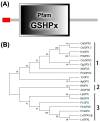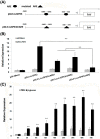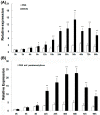A Glutathione Peroxidase Gene from Litopenaeus vannamei Is Involved in Oxidative Stress Responses and Pathogen Infection Resistance
- PMID: 35008992
- PMCID: PMC8745291
- DOI: 10.3390/ijms23010567
A Glutathione Peroxidase Gene from Litopenaeus vannamei Is Involved in Oxidative Stress Responses and Pathogen Infection Resistance
Abstract
In shrimp, several glutathione peroxidase (GPX) genes have been cloned and functionally studied. Increasing evidence suggests the genes' involvement in white spot syndrome virus (WSSV)- or Vibrio alginolyticus-infection resistance. In the present study, a novel GXP gene (LvGPX3) was cloned in Litopenaeus vannamei. Promoter of LvGPX3 was activated by NF-E2-related factor 2. Further study showed that LvGPX3 expression was evidently accelerated by oxidative stress or WSSV or V. alginolyticus infection. Consistently, downregulated expression of LvGPX3 increased the cumulative mortality of WSSV- or V. alginolyticus-infected shrimp. Similar results occurred in shrimp suffering from oxidative stress. Moreover, LvGPX3 was important for enhancing Antimicrobial peptide (AMP) gene expression in S2 cells with lipopolysaccharide treatment. Further, knockdown of LvGPX3 expression significantly suppressed expression of AMPs, such as Penaeidins 2a, Penaeidins 3a and anti-lipopolysaccharide factor 1 in shrimp. AMPs have been proven to be engaged in shrimp WSSV- or V. alginolyticus-infection resistance; it was inferred that LvGPX3 might enhance shrimp immune response under immune challenges, such as increasing expression of AMPs. The regulation mechanism remains to be further studied.
Keywords: Antimicrobial peptide genes; Litopenaeus vannamei; glutathione peroxidase; oxidative stress.
Conflict of interest statement
The authors declare no conflict of interest.
Figures







Similar articles
-
Analysis of expression, cellular localization, and function of three inhibitors of apoptosis (IAPs) from Litopenaeus vannamei during WSSV infection and in regulation of antimicrobial peptide genes (AMPs).PLoS One. 2013 Aug 14;8(8):e72592. doi: 10.1371/journal.pone.0072592. eCollection 2013. PLoS One. 2013. PMID: 23967321 Free PMC article.
-
Litopenaeus vannamei sterile-alpha and armadillo motif containing protein (LvSARM) is involved in regulation of Penaeidins and antilipopolysaccharide factors.PLoS One. 2013;8(2):e52088. doi: 10.1371/journal.pone.0052088. Epub 2013 Feb 6. PLoS One. 2013. PMID: 23405063 Free PMC article.
-
Litopenaeus vannamei Toll-interacting protein (LvTollip) is a potential negative regulator of the shrimp Toll pathway involved in the regulation of the shrimp antimicrobial peptide gene penaeidin-4 (PEN4).Dev Comp Immunol. 2013 Jul-Aug;40(3-4):266-77. doi: 10.1016/j.dci.2013.02.011. Epub 2013 Mar 13. Dev Comp Immunol. 2013. PMID: 23500511
-
A novel Laccase gene from Litopenaeus vannamei is involved in the immune responses to pathogen infection and oxidative stress.Dev Comp Immunol. 2020 Apr;105:103582. doi: 10.1016/j.dci.2019.103582. Epub 2019 Dec 23. Dev Comp Immunol. 2020. PMID: 31874194
-
A Litopenaeus vannamei TRIM32 gene is involved in oxidative stress response and innate immunity.Fish Shellfish Immunol. 2020 Dec;107(Pt B):547-555. doi: 10.1016/j.fsi.2020.11.002. Epub 2020 Nov 6. Fish Shellfish Immunol. 2020. PMID: 33161091
Cited by
-
Ocimum basilicum-Mediated Synthesis of Silver Nanoparticles Induces Innate Immune Responses against Cucumber Mosaic Virus in Squash.Plants (Basel). 2022 Oct 13;11(20):2707. doi: 10.3390/plants11202707. Plants (Basel). 2022. PMID: 36297731 Free PMC article.
-
Transcriptomic variations associated with salinity stress in Penaeus indicus.Mol Biol Rep. 2023 Nov;50(11):9295-9306. doi: 10.1007/s11033-023-08824-4. Epub 2023 Oct 9. Mol Biol Rep. 2023. PMID: 37812353
-
Mitigating Effect of Taurine Combined with Corona Dormancy on Oxidative Stress in Trachinotus ovatus Under Low-Temperature Stress.Int J Mol Sci. 2025 Mar 24;26(7):2927. doi: 10.3390/ijms26072927. Int J Mol Sci. 2025. PMID: 40243503 Free PMC article.
-
Protective and Curative Activities of Paenibacillus polymyxa against Zucchini yellow mosaic virus Infestation in Squash Plants.Biology (Basel). 2022 Jul 30;11(8):1150. doi: 10.3390/biology11081150. Biology (Basel). 2022. PMID: 36009777 Free PMC article.
-
Antiviral Activity of Biosynthesized Silver Nanoparticles from Pomegranate (Punica granatum L.) Peel Extract against Tobacco Mosaic Virus.Plants (Basel). 2023 May 25;12(11):2103. doi: 10.3390/plants12112103. Plants (Basel). 2023. PMID: 37299082 Free PMC article.
References
-
- Koeberle S.C., Gollowitzer A., Laoukili J., Kranenburg O., Werz O., Koeberle A., Kipp A. Distinct and overlapping functions of glutathione peroxidases 1 and 2 in limiting NF-κB-driven inflammation through redox-active mechanisms. Redox Biol. 2020;28:101338. doi: 10.1016/j.redox.2019.101388. - DOI - PMC - PubMed
-
- Borchert A., Kalms J., Roth S.R., Rademacher M., Schmidt A., Holzhutter H.-G., Kühn H., Scheerer P. Crystal structure and functional characterization of selenocysteine-containing glutathione peroxidase 4 suggests an alternative mechanism of peroxide reduction. Biochim. Biophys. Acta (BBA) Mol. Cell Biol. Lipids. 2018;1863:1095–1107. doi: 10.1016/j.bbalip.2018.06.006. - DOI - PubMed
-
- Rojas J., Díaz A.A.B. Chapter 1-Antioxidant Activity of Phenolic Compounds Biosynthesized by Plants and Its Relationship With Prevention of Neurodegenerative Diseases—ScienceDirect. Bioact. Compd. 2019:3–31. doi: 10.1016/B978-0-12-814774-0.00001-3. - DOI
MeSH terms
Substances
LinkOut - more resources
Full Text Sources

